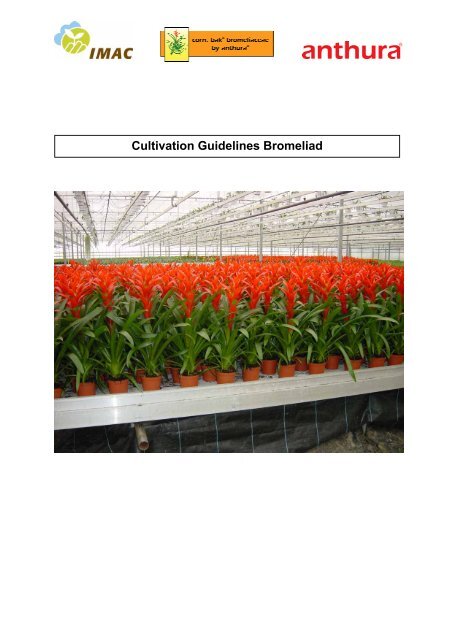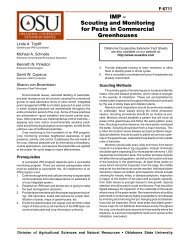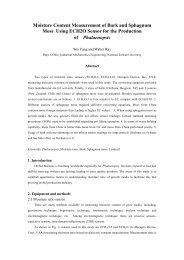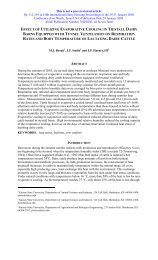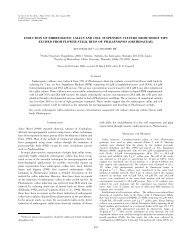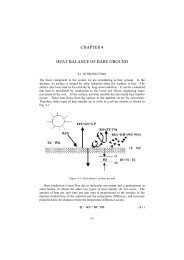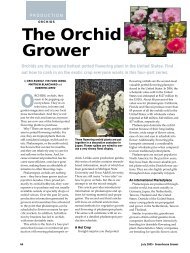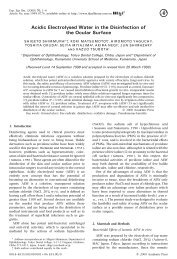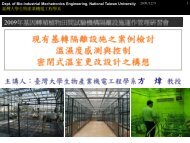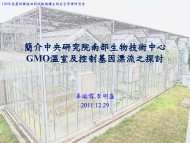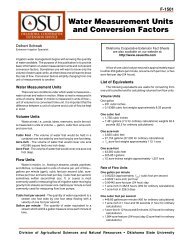Cultivation Guidelines Bromeliad
Cultivation Guidelines Bromeliad
Cultivation Guidelines Bromeliad
- No tags were found...
Create successful ePaper yourself
Turn your PDF publications into a flip-book with our unique Google optimized e-Paper software.
IntroductionThis growing manual describes in short the growing of <strong>Bromeliad</strong>s. Of course this concisehandbook is not all-embracing and the cultivation is subject to new insights and techniques.For more detailed information about the possibilities of this cultivation you can contact AnthuraB.V. For all your growth related questions the consultants of Bureau IMAC Bleiswijk B.V. arepleased to help you.In case you are not familiar with the products of Anthura B.V. and the services of Bureau IMACBleiswijk B.V., please consult the enclosed introduction of both companies.Introduction <strong>Bromeliad</strong>s‘<strong>Bromeliad</strong>’ is in fact a collective name for a group of plants belonging to the Bromeliaceae.Examples of well-known genera are Guzmania, Vriesea, Tillandsia, Aechmea, Neoregelia andNidularium. The various genera can be sub-classified in terms of their leaf margins,inflorescences, and seed types. Guzmania, the best-known genus of the <strong>Bromeliad</strong>s, hasgreen leaves and a star-shaped flower in a variety of colours. Vriesea has a sword-like(feather-shaped) inflorescence; the leaves are either variegated or green. Tillandsia oftenexhibits a pink inflorescence, with blue-violet flowers. Aechmea has silvery leaves with a pinkinflorescence. Neoregelia has red bracts, and the flowers remain within the cup-shaped leafrosette. Nidularium has a yellow inflorescence.Family: BromeliaceaeSubfamily Genus Leaf margin Seed typeTillandsioideae GuzmaniaSmoothPlumousTilandsiaVrieseaBromelioideae AechmeaFully dentate NakedPineappleNeoregeliaNidulariumBromeliaPitcairnioideae PitcairneaDyhiaHechtiaPuyaDentated Base AppendagedIn nature <strong>Bromeliad</strong>s grow in tropical rainforests, and consequently they flourish attemperatures between 20-22°C and a relative humidity of 70%. <strong>Bromeliad</strong>s also requireshaded conditions. <strong>Bromeliad</strong>s are able to absorb nutrients through the roots, the cup, and theleaves (via trichomes). The roots also serve to anchor the plant.Plant materialThe plant material is supplied in the form of plants that have been pricked out either once ortwice during cultivation. Plants that have been pricked out twice are cultivated by the plantsupplier for a longer period of time, and consequently are larger.02/11/03 2
Young plants 1x pricked outYoung plants 2x pricked outThe initial size of the plants used for cultivation depends on the pot diameter, the plant densitysubsequent to potting up, and the required duration of cultivation. The collection of side shootsfrom plants that have already flowered is not an option; these shoots are very irregular,possess less vigour and are of a lower quality. Moreover it is not possible to guarantee thatside shoots are free of disease.On arrival the young plants must be unpacked and allowed to acclimatize under the cultivationconditions. The plants can be potted up once they have become acclimatized. When pottingup the plants it is important to ensure that they are vertical, located in the centre of the pot,and planted at the correct height. The growing point of plants that are planted too deeply aresusceptible to disease, whilst plants that are not planted deeply enough will lack sufficientanchorage and consequently be unstable. It is also important to ensure that the growing pointis not squeezed when the plant is potted up, since this could otherwise result in thedeformation of the foliage or permanent injury to the growing point (resulting in the death of theplant).In general, once the plants have been potted up they will be subdivided into two grades, i.e.plants that have a healthy appearance and are of the correct size, and the smaller plants.Small plants often require a slightly longer cultivation period; small plants that are separated atthe beginning of the cultivation and kept together will exhibit improved growth because ofincreased control, and the absence of competition from larger plants.Using a potting machineCorrect planting depth02/11/03 3
The cultivation planOn reception the plant material may, depending on the type of plant material, the climate, etc.,be too small for immediate potting up into the final pot (larger than 10 cm). In such instances itis preferable to pot up the plants in cell-liner trays or a smaller pot size (7-9 cm).It is preferable to set the pots next to each other once the plants have been potted up, sincethe micro-climate – and consequently the growth – will benefit from as brief as possible adelay before the plants regain contact with each other. The plants must be provided with morespace once the pots and/or the soil are no longer visible. The following table contains anexample of a spacing scheme, in this instance for Guzmania. In general the plants will need tobe put out by an additional 30%, so as to ensure that the leaves regain contact with each otherwithin a period of a few weeks. Depending on the species, the cultivation period and thequantity of light it will be necessary to put out the plants by an additional 30%. Not putting outthe plants for too long will result in the poor development of the flowers, and in smaller plantswith smaller leaves. Premature or excessive spacing of the plants will be detrimental to themicro-climate, and consequently to the growth.Bureau IMAC Bleiswijk B.V. can provide advice about the preparation of a cultivation plan.Example of spacing distances and weeks for the Guzmania group:Operation Plants per m 2 WeeksPot size 7-9 cm Potting up 110 20-2275 18Increase in space 110 - >50 18-2075 - >40 18-20Pot size 11-13 cm Potting up 7-9 cm 75-110 20Potting up 11-13 cm 40-50 20-22Increase in space 20-25 18-20The total cultivation time is 37-45 weeks in 7-9 cm pots and 50-70 weeks for 11-13 cm pots.The substrateWhen selecting the substrate it is important to ensure for the presence of coarse particles forthe drainage and fine particles (not dust) for the retention and distribution of the water and thenutrients. In general, preference is given to a substrate containing 60-70% coarse particlesand 30-40% fine particles. The coarse particles can be comprised of materials such as Irishpeat, bark, or coarse peat. The fine particles can be comprised of perlite, peat litter, or finebark. Ultimately the substrate will need to consist of 50% solids, 25% water, and 25% air. Thesubstrate may not contain an excessive amount of dust, since this will otherwise result in thecompacting of the substrate at the base of the pot. In view of the relative long cultivation periodit is also important to ensure that the substrate does not break down excessively rapidly. Inaddition to the substrate used in the pot, the drainage of the pot is also of importance.02/11/03 4
Subsequent to watering, water may not remain in the lower region of the pot for an excessiveperiod of time. In general pots of a size of between 9-15 cm are used; 9-cm pots are used forcompact plants with a rapid development of the flowers, whilst 15-cm pots are more suitablefor the somewhat larger species and plants requiring a longer cultivation period prior tobecoming ready to flower.<strong>Bromeliad</strong>s are grown both on the ground and in tables/containers. The choice of thecultivation method will depend on the rate of turnover, the automation of the operation, and therequired working height. It is important to ensure that the plants are provided with appropriatedrainage, and that water can be supplied to the cup of the plants.The irrigation systemIn view of the <strong>Bromeliad</strong>’s ability to absorb nutrients through the cell tissue of the cup it isimportant to ensure that they are watered from above using either sprinkler lines or spraybooms. The water must be free of chemical and visible contamination; moreover the watermay not contain an amount of elements such as sodium and chlorine in excess of 50 mg/l, andmay not contain an excessive amount of bicarbonate. In the absence of supplies of goodqualitywater it will be necessary to make use of reverse-osmosis water.The quantity of water required by the plants depends on the climate, the substrate, and theage of the crop. The irrigation system must be capable of supplying between 5-12 litres ofwater per m 2 . Sufficient water has been given once all the cups overflow.Fertilizers<strong>Bromeliad</strong> cultivation can employ either compound fertilizers, a system with separate mixingtanks for the fertilizers, or compound fertilisers using a Dosatron ® . General advice based onthe use of mixing tanks for the fertilizer is enclosed with these guidelines. The needs may varyfrom variety to variety; Bureau IMAC Bleiswijk B.V. can be requested to provide customisedadvice for the relevant variety.Caution should be exercised with the use of the elements phosphate, boron, zinc, and copper.Higher concentrations readily result in tip-burn, retardation of growth, and die-back. It is alsoimportant to bear in mind that some pesticides can contain copper and zinc. When using abasic fertilizer on a peat substrate it is important to ensure that the mix does not contain anexcessive amount of Dolokal (< 2-3 kg/m 3 ). In addition, 0.5 PG mix (12-14-24) per m 3 is morethan adequate. This should result in a pH of the substrate of about 5.5, and an EC of 0.5mS/cm.The EC of the nutrient solution should lie within the range between 0.8 and 1.0 mS/cm; asubsequent rinse with a lower EC is required. Tillandsia and Vriesea exhibit the greatestvulnerability to excessive levels of nutrient salts. The pH may fluctuate between 5.2 and 6.2.In view of their low needs for CO 2 <strong>Bromeliad</strong>s do not need supplementary CO 2 .02/11/03 5
System: Mixing tank; 1,000 litre tanksWater supply: 100% rainwaterA - solution, a concentration of 100 timesNitrate of lime Ca(NO 3 ) 2 19.0% Ca, 15.5% N 0,0 kg.Ammonium Nitrate (liquid) NH 4 NO 3 18% N (9.0% NO3 and 9.0% NH 4 ) 9,0 kg.Nitric acid 38% HNO 3 8.4% N, 6.0 mol H 3 O + per kg 0,0 ltr.Potassium nitrate KNO 3 38.2% K, 13.0% N 14,8 kg.Iron chelate 3% (DTPA) 0,0 kg.B - solution, a concentration of 100 timesPhosphoric acid 59% H 3 PO 4 26.8% P, 8.6 mol H 3 O + per kg 0,0 ltr.Potassium nitrate KNO 3 38.2% K, 13.0% N 17,3 kg.Potassium dihydratephosphateKH 2 PO 4 28.2% K, 22.3 % P4,0 kg.Potassium sulphate K 2 SO 4 44.8% K, 17.0 % S 0,0 kg.Epsom salt MgSO 4 9.9% Mg, 13.0 S 2,5 kg.Manganese sulphate MnSO 4 32.5 % Mn 0,0 g.Borax Na 2 B 4 O 7 11.3% B 0,0 g.Zinc sulphate ZnSO 4 22.7% Zn 0,0 g.Copper sulphate CuSO 4 25.5% Cu 0,0 g.Sodium molybdate Na 2 MoO 4 39.6% Mo 0,0 g.The climateTemperature<strong>Bromeliad</strong>s are subtropical plants, and consequently temperatures lower than 14°C and above35°C should be avoided. For an appropriate growth endeavours should be made to maintainan average temperature of 18-20°C.Relative humidityAn excessively low relative humidity will retard the rate of photosynthesis, whilst anexcessively high relative humidity will increase the risk of problems with moulds. However it isimportant that more moisture is present at higher light intensities. Countries with a climatepossesing a high relative humidity may make use of higher daytime temperatures and lightintensities. Endeavours should be made to maintain the relative humidity in the range between60 and 80%. In situations in which the relative humidity is too low – and certainly incombination with higher temperatures – it is in important to install systems that will increasethe relative humidity, such as systems that do not wet the crop (for example, high-pressurehumidification in the upper regions of the glasshouse, sprinkler lines under the pots, path/fansystems, etc.)02/11/03 6
Light intensityExcessive light intensities will often result in pale foliage and flowers, whilst it is also possiblethat the foliage will acquire a red tint (depending on the species) and become burnt.Inadequate light intensities result in straggly and poor quality plants. At a maximum of 1400Watt/m 2 on sunny days a shading percentage of 80% will be required, which can be achievedby the use of chalking and/or screens. The following light intensities at the level of the plantsare recommended for the species shown below:Aechmea30,000 luxGuzmania 18,000 - 22,000 luxNeoregelia 25,000 luxTillandsia 25,000 - 30,000 luxVriesea 18,000 - 20,000 luxToo much light exposed to VrieseaFor cultivation in tropical countries a screening net offering 80% shading is required.Preference is given to the use of two nets, i.e. a fixed net providing 60% shading and a secondmovable net offering 50% shading. The movable net can be closed during sunny periods andat the middle of the day, thereby avoiding peaks in the light intensity.The use of plastic screens is recommended when <strong>Bromeliad</strong>s are grown in regions with agreat deal of rain, since this will result in a drier crop and a reduced incidence of disease(bacteria and moulds). An additional benefit offered in these conditions is the reduced degreeof the leaching of nutrients from the substrate; as a result the nutrient concentration in the potsand the cups will remain optimal, in turn ensuring for a more rapid growth and the eliminationof the risk of the plants suffering from deficiencies of nutrients. So as to provide for a constanttemperature and to ensure a good circulation of the air it is recommended that the gutterheight should be between 3-4 metres.For the purposes of subsequent thorough analyses of any cultivation problems that may occurit is important that suitable records be made of the most important climatic parameters, suchas the light intensity, temperature, and relative humidity. These measurements should bemade using a climate computer or hand-held meters; records should be kept of the minimumand maximum daily values.02/11/03 7
GasesThe ageing hormone ethylene is used to ensure that <strong>Bromeliad</strong>s flower simultaneously and inaccordance with the scheduling. This flowering treatment can commence once the plants havegrown sufficient foliage. Gassing is usually effected using acetylene (C 2 H 2 ), which is dissolvedin water and then poured into the cups. An appropriate concentration is achieved by bubblingacetylene gas at a pressure of 0.5 bar through 100 litres of water for at least 30 minutes. Theideal temperature of the water is about 20°C, since water at this temperature containssufficient gas for the treatment whilst not being excessively cold for the plant. This treatment ismost likely to be successful when carried out in the morning at high light intensities, since theplant will then be able to absorb the gas throughout the entire day; moreover the temperatureis lower in the morning, resulting in a reduced evaporation of the gas during the first hours ofthe treatment. Two treatments will suffice at adequate light intensities; otherwise two to threetreatments will readily be required if the treatment is to succeed.Bubbling Acetylene gas in a tankA mixing system for acetylene gasThe number of treatments also depends on the species; when in doubt an additional treatmentshould be given to prevent partial flower induction. If flower induction is to be achieved then itis important that level of nutrients available to the plants is low prior to the flowering treatment.Consequently it is important that the fertilization is halted in good time, and that the fertilizationis then recommenced so as to restore the colour to the crop. A treatment with Ethrel isnecessary for Tillandsia and optional for the green-leaved Vriesea. However more damagemay be caused by the use of Ethrel if it is employed without due caution.Bottle with acetylene gasFilling of the cups02/11/03 8
Partial flower inductionPartial flower inductionDiseases and pestsThe most significant diseases afflicting <strong>Bromeliad</strong>s are moulds, mites, and thrips.ExsorhilliumNeoregelia is susceptible to the mould Exsorhillium; diseased plants exhibit brown spots whichspread to the base and ultimately result in the death of the plant. Measures to retard mouldgrowth such as good hygiene, a reduced relative humidity and an anti-fungal treatment arerequired to prevent further loss.MitesThe pineapple mite and the straw mite are the most harmful species of mites infesting<strong>Bromeliad</strong>s. These microscopic mites live in the cup, causing deformation of the flowers anddiscolouration of the foliage. The red spider mite can also infest <strong>Bromeliad</strong>s; these mites liveon the foliage, and cause a silvery discolouration.Sciaridae (fungus gnats)Large numbers of sciarid larvae attack the root tips; large numbers of larvae of these fungusgnats are particularly likely to be found in the last plants of big lots. The preventive deploymentof the Hypoaspis predatory mite (100-150/m 2 ) is often sufficient to prevent infestation.You can contact Bureau IMAC Bleiswijk B.V. for adequate pest-control measures. Cautionshould be exercised with respect to phytotoxicity; not all chemical agents can be used on<strong>Bromeliad</strong>s without causing damage. Any new pesticide agent should be tested on a fewplants prior to large-scale use. Moreover the concentrations stated on the packaging are oftentoo low – and, on occasion, too high. Always contact Bureau IMAC Bleiswijk B.V. if there isany cause for doubt. It is also necessary to take account of the slow response of the plantswhen making an assessment of the effectiveness of a treatment.02/11/03 9
SaleThe plants are ready for sale once the flowers have developed to a sufficient extent. WithAchmea this point has arrived when a bud has opened above the edge of the cup, whilst withGuzmania and Vriesea the flower needs to have acquired its colour. When the plant is madeready for sale any damaged leaves are removed, the water is emptied from the cup, and theplant is wrapped in a sleeve. It is important that the temperature does not fall below 18°Cduring transport.Guzmania ready for saleTillandsia ready for saleWe hope that these brief cultivation guidelines will have given you an insight into thecultivation of <strong>Bromeliad</strong>s. Although the cultivation of <strong>Bromeliad</strong>s is a specialized operation, it iscertainly feasible provided that a number of conditions are met. Growers who fulfil theseconditions will be rewarded with a beautiful plant that can readily be kept in a good condition,and which deserves an excellent place in the market. You are welcome to contact us shouldyou have any additional questions, or require a further explanation of any issues.Anthura B.V. and Bureau IMAC Bleiswijk B.V. cannot accept any liability whatsoever for any damage that may becaused to the crop by following the advice in these guidelines. Moreover in view of the fact that many factors areboth outside of our influence and our control we are unable to guarantee specific results.02/11/03 10
Introduction Anthura B.V.Anthura B.V. is the world market leader for planting material of Anthurium for pot plant and cutflower culture with greenhouses covering 14 hectares. Besides Anthurium we specialise in thebreeding, selection and propagation of Phalaenopsis for pot plant and cut flower culture.<strong>Bromeliad</strong> completes our current product assortment, and we are happy to offer growersabroad planting material from Corn. Bak B.V. From a growers perspective all of these productsare compatible and in many countries are cultivated next to each other. At the establishmentsin the Netherlands (Bleiswijk) are 180 workers employed and at the establishment in Germany(Borken-Burlo) are 55 workers employed.It is important that before you begin planting you are thoroughly acquainted with the varioushusbandry methods we recommend here. This will enable you to make a good start and allowyour crop to realise its full potentials. Additional information can be sought through our visitingrepresentatives and agents as well as from the independent consultant agency Bureau IMACBleiswijk B.V. Alternatively you can contact the Anthura Sales department.Anthura B.V. Phone.: +31 10 529 1919Anthuriumweg 14 Fax: +31 10 529 19292665 KV BLEISWIJK E-mail: info@anthura.nlTHE NETHERLANDS Internet: www.anthura.nlIntroduction Bureau IMAC Bleiswijk B.V.IMAC consultants are well educated individuals equipped with a great deal of practicalexperience gathered at home and abroad and dedicated to your success and ultimately to ourown. Consequently there is a great deal of information exchange between our respectiveorganisations upon which growers may call.Because of our small-scaled mode of operation and a good consultative structure within ourwalls we keep each other well informed about the developments in the various cultures. Owingto the unique co-operation with Anthura a broad exchange of knowledge takes place betweenboth companies without affecting the independence of IMAC. The activities of IMAC are notlimited to the Netherlands only. Many foreign growers make use of the services of ourconsultation agency. Because of this international character the IMAC consultant is able morethan anybody else to get the most out of your cultivation under your specific circumstances.Activities of IMAC services world-wide include: advice on cultivation and management, supportof study groups, fertilisation analysis and advice, studies in the fields of plant disease,business economics, plant evaluation and pot plant planning.For more information, without obligation, please contact any of the following: Mr Ing. André Lont,Mrs Ir. Josien van Spingelen or Mr Ing. Albert van Os, consultants at Bureau IMAC Bleiswijk B.V.Bureau IMAC Bleiswijk B.V. Phone: +31 10 521 90 94Anthuriumweg 12 Fax: +31 10 521 82 302665 KV BLEISWIJK E-mail: info@imac-bleiswijk.nl02/11/03 11


